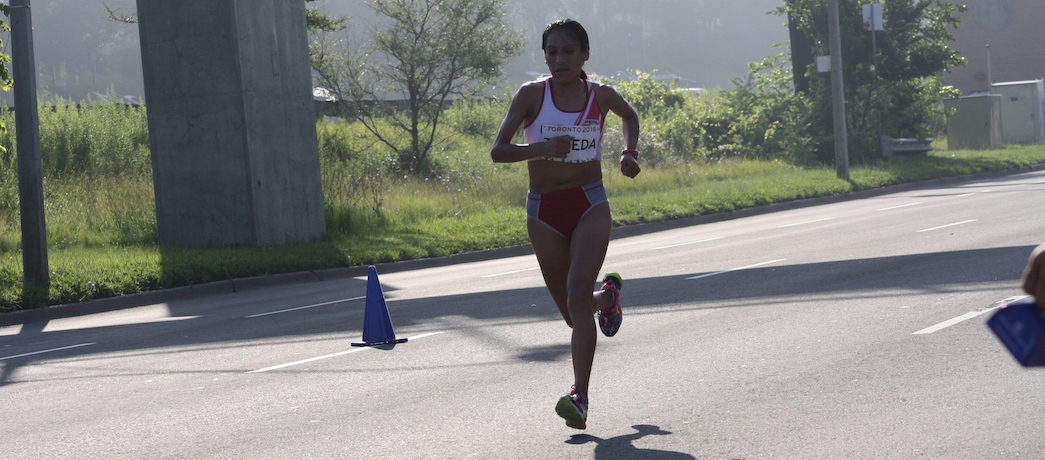The trouble with Ostarine: Jimmy Wallhead’s
16th March 2018
Features


The Pan American Sports Organisation (PASO) has confirmed six more adverse analytical findings (AAFs) at the Toronto 2015 Pan American Games, taking the total to 17 confirmed positive tests. In an 8 September statement, PASO confirmed that Toronto 2015 women’s marathon winner Gladys Tejeda (pictured) had tested positive for furosemide, and that her gold medal would be forfeited and awarded to Adriana da Silva of Brazil.
The Peruvian Olympic Committee (POC) said that Tejeda had reported to doping control that she had used the Lasix diuretic brand. ‘Unfortunately, this substance is prohibited under anti-doping regulations because it is used by some athletes to mask the use of other banned substances’, read a POC statement. ‘The case has been officially communicated to the International Association of Athletics Federations (IAAF) which has provisionally suspended the athlete, pending a penalty set by the Peruvian sports federation’. As previously reported by the Sports Integrity Initiative, the POC had previously claimed that Tejeda’s positive was due to medical issues.
PASO also confirmed that María Luisa Calle Williams had tested positive for GHRP-2, a growth hormone releasing peptide. Her positive had previously been confirmed by the Colombian Olympic Committee (COC) in a 22 July statement, as reported by the Sports Integrity Initiative, however that statement has since been removed from the COC’s internet site.
PASO also confirmed that Sheila Ocasio, a Puerto Rican volleyball player, has tested positive for stanozolol. As reported by the Sports Integrity Initiative, Ocasio has previously denied using prohibited substances at any point in her career.
PASO also confirmed marathon runner Christopher Guajardo’s AAF, reported by the Sports Integrity Initiative in July, was for erythropoietin (EPO). It also confirmed two new positives for anabolic steroids, the first being for Panama footballer, Richard Peralta Robledo, who tested positive for clostebol. The second was María Pastuña’s AAF for nandrolone. Pastuña finished sixth in the 5,000m and 12th in the 10,000m at Toronto 2015.
PASO has yet to confirm two further AAFs, which would take the total number of athletes reporting doping positives at Toronto 2015 to 19. It is understood that both athletes have asked for their B samples to be analysed, which might explain why the positive tests have yet to be confirmed by PASO. The first involves Guatemalan weightlifter Astrid Roxanna Camposeco Hernandez, whose AAF was confirmed by the Guatemalan Olympic Committee (COG) in a 13 July statement, as reported by the Sports Integrity Initiative.
The second involves Chilean cyclist Carlos Oyarzun, who has already qualified for the 2016 Rio Olympic Games, but is understood to have tested positive for FG-4592, as reported by the Sports Integrity Initiative in July. The hypoxia-inducible factor (HIF) stabiliser was added to section S2 of the World Anti-Doping Agency’s Prohibited List in 2011. On 29 July, the UCI suspended the Androni Giocattoli-Sidermec Pro Continental team for 30 days, after rider Fabio Taborre reported an adverse analytical finding for FG-4592. In April, the French anti-doping agency (AFLD) confirmed a positive test for FG-4592 on race-walker Bertrand Molinet.
FG-4592, sometimes called ‘oxygen in a pill’, stimulates the production of erythropoietin (EPO) inside the body (endogenous). Unlike exogenous (externally administered) EPO, it is available in pill form and works in combatting anaemia by increasing an individual’s ability to produce red blood cells. As red blood cells contain iron, this helps combat anaemia, but red blood cells also carry oxygen around the body – specifically to the muscles. It is also understood that FG-4592 doesn’t raise blood pressure in the same way as EPO, reducing the risk of heart attacks due to ‘thickened’ blood.
• Eleven athletes (and a horse trainer) from eleven countries, competing in nine sports, were...
• 20 athletes from nine countries, competing in ten sports, were involved in anti-doping proceedings...
• Twenty four athletes from 13 countries, competing in eight sports, were involved in anti-doping...